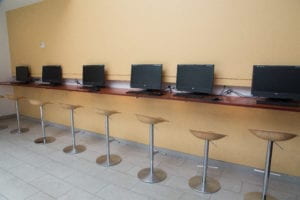 With buildings largely quiet besides non-essential employees, NYU has dramatically decreased energy usage across campus. Much of that reduction occurred organically as people departed their residences or workplaces, turning off lights and bringing home laptops. But, a number of devices — such as printers, copiers, student computer clusters, lobby displays, desk phones, coffee makers and microwaves — were left on.
With buildings largely quiet besides non-essential employees, NYU has dramatically decreased energy usage across campus. Much of that reduction occurred organically as people departed their residences or workplaces, turning off lights and bringing home laptops. But, a number of devices — such as printers, copiers, student computer clusters, lobby displays, desk phones, coffee makers and microwaves — were left on.
NYU has undertaken a concerted effort to shut down these ancillary devices during this period of remote study and telework. Even though the carbon savings may be short-lived (as most items will be turned on post-remote period) the cost savings are critical considering the financial impact of COVID-19. The energy draw of all those coffee makers and copiers, even in standby mode, is over 200 kilowatts – enough to power a small apartment building. NYU has mapped out about 7 million square feet of area in campus buildings that could add up to over $30,000 per month in energy savings through shutting down unused devices for every month that campus is closed to non-essential employees.
Nevertheless, considering the large span of campus: it is no easy feat figuring out what to shut off, while double checking that no essential devices (or devices being accessed remotely) will be negatively affected. And, then the final step: actually turning the devices off. Here is how our team accomplished this:
- NYU Energy Engineering, IT, and Office of Sustainability came up with a list of potential items to shut down. Items were separated into categories based upon who would be able to actually turn devices off, be it school or central administration facility directors, building operators, central campus or technical services, and so forth.
- Energy savings were forecast for each item based upon estimates of the number of that type of device across campus, device energy usage, and how many devices out of the total numbers were still on and could be turned off. Actions were then deemed High, Medium, or Low impact based on energy cost savings.
- The difficulty level of each action was also ranked High, Medium, or Low based on a number of factors: labor requirement, risk of turning off essential items, lack of clarity about how something would/could be turned off, or for other reasons.
- Items with High or Medium impact and Low or Medium difficulty were prioritized, whereas items with Low Impact and High or Medium difficulty deprioritized. Items that could be turned off remotely were also prioritized.
- The list was reviewed by unit leaders and schools. Individual instances of devices that needed to be left on were added to a shared document so they would not be affected. Areas occupied by essential workers were deprioritized, as were labs and research areas.
- The team walked through floor by floor, shutting things off, excluding items marked on the shared document.
Some examples of how this worked in practice:
- Pantry refrigerators are unneeded in empty offices, and turning them off was forecast as having Medium impact (several thousand dollars per month energy savings). However, turning them off would require each fridge to be emptied, cleaned, and the door propped open – a lot of work. Perhaps we may be able to get back to this later.
- Computer clusters (for students use or employee training) could often be turned off remotely. We asked administrators who did to note it on the shared document, to track progress and savings. Nevertheless many public-area computers stayed on although they were not being used, and those were shut off as part of the effort.
- Large lobby or informational displays can be big energy users, as they are often on 24-7. We forecast a surprising High impact from turning these off, and it is straightforward to accomplish — so this item was a key priority. However street-facing lobby lighting was generally left on for security.
- Copiers, printers, and multifunction devices – when not needed by essential personnel on campus – are Medium savings (even if they are in “standby” mode) but very easy to turn off.
- Essential equipment, individual user PCs, researchers’ equipment, lab equipment, networking infrastructure, and emergency equipment, were not on the shutdown list.
- We also did not cut power to floors, to make it easy to turn on an individual piece of equipment if needed. We also informed users that anything turned off inappropriately could be turned back on.
An energy-saving best practice: even if you think a device is turned off — do check and turn it “all of the way off” whenever possible. The COVID-19 impact is bringing this best practice to light. If you are using more energy while working or studying from home, implementing these easy actions can help you save on your monthly electric bill. When the NYU community returns to our buildings and offices, hopefully some of these energy saving practices – turning off equipment overnight and for weekends and holidays – will continue. This is one of the easiest and lowest-cost actions that each of us can do to reduce our energy consumption.
Thanks to Kim Musler in NYUIT for help preparing for device shutdowns and with this blog.
